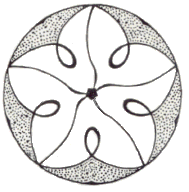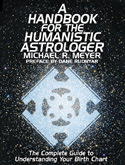

|
|
|
|

Venus Morning Star, Venus Evening Star
Introduction 1
This feature consist of seven pages: Introduction 1 Introduction 2 Lucifer-Retrograde Lucifer-Direct Hesperus-Direct Hesperus-Retrograde Progressed Venus Cycle
The All-Seeing Eye knows if you haven't made a voluntary donation to view the online collection of Astrological Articles at CyberWorld Khaldea. The suggested contribution is $12, but you may offer as little as $3 or as much as $50. The Honor System at Amazon.com make's it safe and easy. You can help the work! Please make a donation today!

The 584-day cycle of Venus begins at the inferior conjunction, when Venus is in the middle of its retrograde period.
 Lucifer is from the Greek, meaning "Light Bringer"; Hesperus means "Western."  
The stylized diagram of the 5 sequential Venus cycle above, which includes 5 retrograde loops, is a symbol of ancient Vedic mythology, signifying the Holy Kumaras, the Promethean Beings or Fiery Pentagrams from Sukra (the Hindu word for Venus, though not necessarily the physical planet) who gave to infant humanity the spark of intelligence and the seed of individuality - for better and for worse.
 A HANDBOOK FOR THE HUMANISTIC ASTROLOGER The Complete Guide to Understanding Your Birth Chart
Now available in
Paperback and eBook Formats |

If you're one of the millions who give attention to astrology, or have had your birth chart drawn and interpreted, you probably know the zodiacal sign and natal house occupied by Venus at the time of your birth. The natal house in which Venus was located at birth shows the particular set of human experiences through which your emotional life, feeling nature and sense of values, fueled by the type of energy symbolized by Venus' sign, best operates.
But a house and sign examination is not the most fundamental astrological key revealing your Venusian nature. This article presents a basic, easy-to-use technique to determine and interpret your Venus type. It is based on viewing the 584-day cycle between the Sun and Venus as a whole. Readers of my series on mental types, The Four Faces of Mercury, will recognized that the Venus cycle follows a pattern similar to the cycle of Mercury, but with some important and very intriguing variations. The approximately 116-day cycle of the Sun and Mercury deals with mental processes, associations and attitudes, while the cycle of Venus symbolizes emotional processes and attitudes, as well as our value-and-meaning-giving faculties – that is, how we interpret, evaluate and make sense of our life-experiences and the world around us. Whereas Mercury is the neutral and asexual planet, the servant and messenger of other planets and their functions, Venus is assigned a feminine polarity; it represents the set of values motivating our actions (Mars) and guiding our mental processes and use of knowledge (Mercury). But the most unique and fascinating feature of the cycle of Venus is the remarkable way it conforms, cycle after cycle, to a five-fold pattern. The Cycle of Venus and Its Five-Fold Pattern Because the orbit of Venus lies within Earth's, from our geocentric point of view Venus always leads or follows the Sun by no more than 47.5 degrees. Another special feature of the Venus cycle (which it shares with the Mercury cycle, because the two bodies both lie within earth's orbit) is that Venus forms two very different types of geocentric conjunctions with the Sun — the inferior conjunction and the superior conjunction. A Venus cycle begins at the inferior conjunction, when Venus is exactly between the Sun and the Earth. At the superior conjunction, which is equivalent to the opposition aspect, Venus is on the far side of the Sun, with the Sun standing exactly between the Earth and Venus. The inferior conjunction, equivalent to the New Moon phase of the lunation cycle, occurs when Venus is in the middle of its retrograde cycle and moving quite slowly across the zodiac. It is then nearest to the Earth and, from our point of view, dark. Rising before the Sun, Venus appears in the pre-dawn sky about a week after the inferior conjunction, when the Sun and Venus are about ten degrees apart. As a herald of the new day, Venus is called Phosphorus and Lucifer, the latter name meaning "light bearer." 

Venus turns direct about three weeks after the inferior conjunction. Thirty-six days after the inferior conjunction, Venus is most brilliant in the morning sky. Thirty-six days more, Venus reaches its maximum distance from the Sun. At this time, Venus is moving through the zodiac at the same speed as the Sun, and gaining. Two-hundred and sixteen days (or 6 x 36 days) later, Venus reaches its superior conjunction with the Sun, when it is moving close to its maximum of speed of about 1°15' per day. For several weeks before and after the superior conjunction, however, Venus is so close to the Sun in the sky that it is no longer visible. Venus is furthest from the Earth at superior conjunction, which is equivalent to the opposition aspect and the Full Moon phase of the lunation cycle. The superior conjunction inaugurates the hemicycle in which Venus plays the role of the Evening Star, Hesperus, which means western. Thirty-six days after the superior conjunction, when the Sun and Venus are about ten zodiacal degrees apart, Venus first appears in the evening sky, setting after the Sun. Two-hundred and sixteen days (6 x 36 days) after the superior conjunction, Venus again reaches its maximum distance from the Sun — about 47 degrees, but maximum elongation varies slightly from cycle to cycle. It occurs when the motion of Venus equals the Sun's, and is slowing. Thirty-six days later (which is also thirty-six days before the next inferior conjunction), Venus is most brilliant, outshining all other objects in the evening sky . Then, about two weeks later, Venus begins its forty-day retrograde journey, in the middle of which occurs the inferior conjunction, the birth of new cycle. But about twelve days before the inferior conjunction Venus becomes no longer visible in the sky. Because Venus rotates one-hundred and eighty degrees on its polar axis between inferior conjunctions, at each superior conjunction Venus shows Earth the face that during the inferior conjunction faced the Sun, while the side that was facing the Earth during the conjunction now faces the Sun. But this is not the most extraordinary feature of the Venus cycle. When one plots the cycle of any important turning point of the cycle of Venus for five or more consecutive cycles, a remarkable pattern forcefully emerges — a five-pointed star! 

So many factors figure into the remarkably stable five-fold structure of the Venus cycle that we can only outline here a few of the most important. The most striking features of the pentadic structure include: 1) a superior conjunction occurs very near to 648 degrees (one complete circuit around the zodiac plus 288 degrees or four points of a five-pointed star) from the inferior conjunction which opened its cycle; 2) successive inferior conjunctions occur about 936 degrees zodiacal degrees apart — that's two circuits around the zodiac, plus 216 degrees or three points of a five-pointed star; 3) this patterns repeats itself in terms of the zodiacal degrees on which Venus turns retrograde and direct, as well as the degrees of greatest brightness and maximum elongation; 4) a complete pentagram is formed after five complete cycles, totaling two days, eight hours short of eight years; 5) successive five-cycle sets identically repeat the pattern, with an offset of only two zodiacal degrees; and 6) the star pattern created by five Venus cycle rotates backwards through the zodiac, completing an entire round once every 760 Venus cycles, which adds up to about 1,215 years. Additionally, phenomenon of Venus occur in steps of thirty-six days or in multiples of thirty-six. Maximum brightness occurs thirty-six days after the inferior conjunction; the next step, maximum elongation occurs thirty-six days later; and the superior conjunction occurs 216 days (or 6 x 36 days) after maximum elongation. In the evening star phase, maximum elongation occurs 216 days after the superior conjunction; maximum brightness takes place thirty-six days following maximum elongation and thirty-six days more brings the inferior conjunction.
Introduction 1
Introduction 2 Lucifer-Retrograde Lucifer-Direct Hesperus-Direct Hesperus-Retrograde Progressed Venus Cycle Text and graphics copyright © 2001 by Michael R. Meyer. All Rights Reserved.  mail@khaldea.com Web design and all data, text and graphics appearing on this site are protected by US and International Copyright and are not to be reproduced, distributed, circulated, offered for sale, or given away, in any form, by any means, electronic or conventional. Unless otherwise noted, all text, data and graphics appearing on this site are copyright © 2000-2010 by Michael R. Meyer. All Rights Reserved. See Notices for copyright statement, conditions of use, and disclaimer. |About|Calendar|Ephemeris| |Charts|Art Gallery|Library|Resources| |Shop|Links|Rudhyar Archival Project|Help| Web design and programming for this entire site copyright © 2000-2004 by Michael R. Meyer. |
